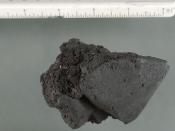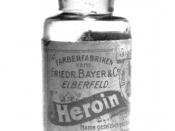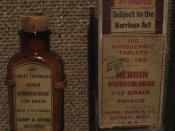Heroin Introduction Heroin is an illegal, highly addictive drug. It is an opiate, which produced from the liquid sap of the opium poppy plant. It was first developed in Germany in 1898 as a stronger and supposedly non-addictive form of morphine. Usually, it is sold as a white or brownish powder or as the black sticky substance Known on the streets as áçblack tar heroináè. Although white and brownish powder is becoming more common, most streets heroin is mixed with other drugs such as sugar, starch, powdered milk, quince, and strychnine or other poisons. Heroin can often lead to overdose and death. It is usually injected, sniffed, or smoked, so many diseased such as HIV can be spread by sharing needles. Heroin user may inject up to four times per day. When heroin is sniffed or smoked, peak effects are usually felt within ten to fifteen minutes. Heroin is three times more portent than morphine.
It also has three nicknamed: áçHáè,áçhorseáè, andáçsmackáè.
Short-Term Effects Once it is injected, heroin crosses the blood-brain barrier. In the brain, heroin is converted into morphine. Abusers usually report feeling a surge of pleasurable sensation, a áçrusháè. The intensity of the rush depends on how many drugs are taken and how fast it enters the brain. Heroin is especially addictive because it enters the brain so quickly. The short-term effect rush is usually accompanied by a warm flushing of the skin, dry mouth, and a heavy feeling in extremities, which may be accompanied by nausea, vomiting and severe itching. Heroin can damage the limbic system, which controls emotion to increase feelings of pleasure. It can block pain messages transmitted by the spinal cord from the body. It can also change the brain stem, an area that controls automatic functions, and depress breathing. After the initial...


